Game of Thrones has always had elements of horror: white walkers, murderous cults, incurable diseases, man-eating dragons, and the like. But Sunday night, the show covered truly terrifying ground: family dinners. Samwell Tarly’s long-awaited reunion with his family couldn’t have gone worse, and Gilly didn’t make too great an impression either. The blame can be laid squarely at the feet of Samwell’s father, Lord Randyll Tarly. This wasn’t exactly unexpected, given that the last time he saw his son, he threatened to murder him if he didn’t renounce all claims to his inheritance and head into exile in the North. As Sam puts it earlier in the episode, “a person just doesn’t feel welcome at that point.” But Lord Tarly managed to exceed even those low expectations.
So how does one film the least welcoming dinner since the Red Wedding? In a show that lives on sweeping vistas, wide shots, and carefully choreographed action, it may be surprising that a subject as simple as a meal would demand as much attention on the level of craft—and it’s true that nothing cinematically revolutionary happens in the six-and-a-half-minute scene. But director Jack Bender, cinematographer Jonathan Freeman, and editor Yan Miles still do everything they can to give the scene a feeling of unease as they track the shifting power relationships around the Tarwell family table.
The first thing to notice about the dinner is that it uses exceptionally fast cuts. In six minutes and 22 seconds, there are 134 individual shots, meaning that on average, each one is about 2.85 seconds long. Average shot length is a crude (and boring) metric the same way any average is, but it can give a general idea of the pace of editing—and 2.85 seconds is more typical of a car chase or sword fight than a meal. For example, this dinner scene from American Beauty, hardly languid, has an average shot length of about 4.5 seconds. Even Eisenstein, who more or less invented fast cutting, averages about 7 seconds a shot in the wedding banquet in Ivan the Terrible. Game of Thrones generally uses very fast cutting, but this is manic even for them. By way of contrast, the scene immediately preceding the dinner, in which Sam sees Gilly in a nice dress for the first time, has shots nearly twice as long. Yan Miles lets that moment breathe—but once everyone’s seated at table, he tightens the ratchet.
To further disorient the audience, there’s a clever bit of camera placement in the dinner’s initial shots:
After a very brief establishing shot, too far from the table to really get a sense of how far apart from each other people are seated, Bender and Freeman give us an eyeline match between Randyll and his son:
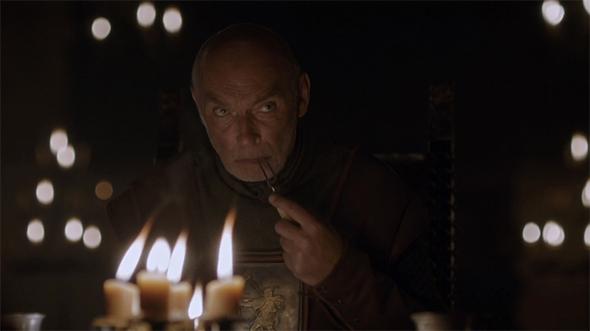
HBO
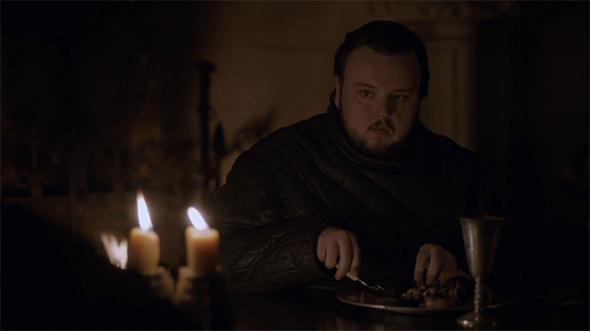
HBO
You only need two shots for this, but in keeping with the scene’s mandate to be as manic as possible, Miles chops it into four. The natural assumption is that we’re seeing Lord Tarly from Sam’s perspective and vice versa—the shadow in the lower left here should be Tarly’s shoulder. It’s followed by a standard eyeline match between Gilly and Sam’s mother, confirming that everything’s normal:
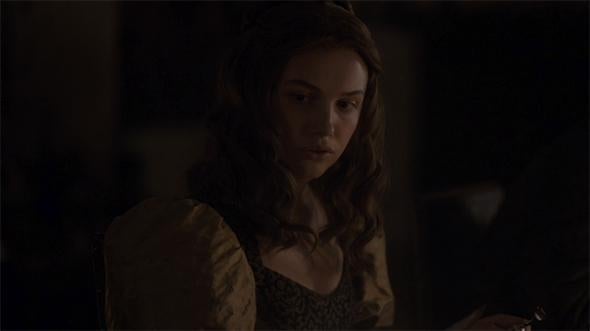
HBO

HBO
The framing of Sam and Randyll places them relatively near each other at the table. It’s only once Sam botches his first attempt at conversation by asking if the venison he’s eating is from that day’s hunt—when a hunter would (apparently) realize it wouldn’t have been cured yet—that we get this shot, which Jack Bender will return to as thing go further and further south:

HBO
Lord Randyll and Sam are much farther away than the early shots led us to believe, so much so that Sam’s out of focus. In fact, the earlier shots were over Sam’s brother’s shoulder, not his father’s. The more ashamed Sam feels (and the more Randyll is dominating the conversation), the more often the filmmakers return to this framing. It’s immediately followed by an angle that puts the two men miles apart, as Sam awkwardly apologizes for his blunder:
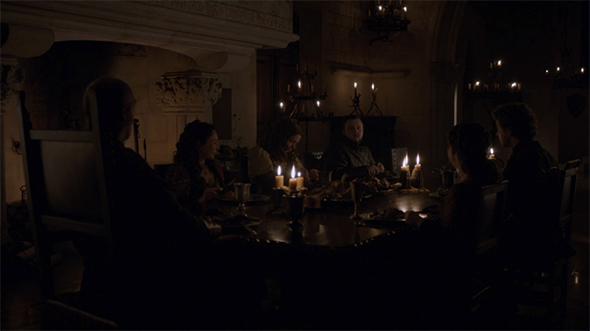
HBO
When Sam briefly regains control of the conversation, telling his family that he, too, hunts now, the framing cuts Lord Tarly out of the picture entirely and brings the focus to Sam.
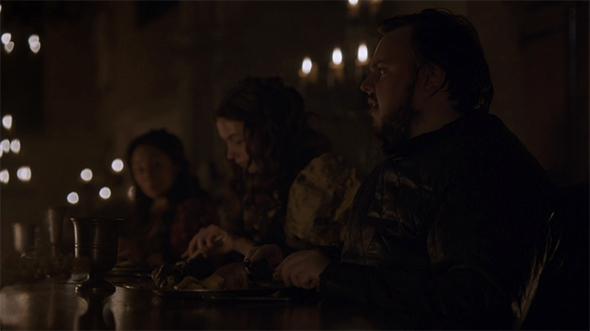
HBO
For the brief moment when it seems like things are going OK—despite Sam’s clarification that he only hunts rabbits, and it’s mostly his friends who do the hunting—the filmmakers use mostly medium shots, nothing too alarming. Randyll even gets a moment of something approaching amusement at his daughter’s suggestion that she should be taught to hunt. Then, regrettably, Sam asks for more bread.
Note that the offer of food comes in a shot without Lord Tarly, as used before when Sam was in control of the conversation.
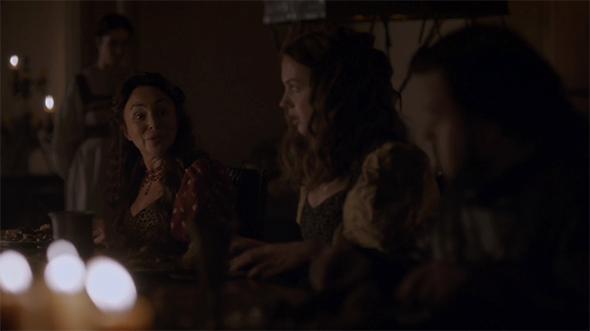
HBO
But when Randyll takes over with the line “Not fat enough already?” we get only Sam and his father in frame, focus pulled to the older man:
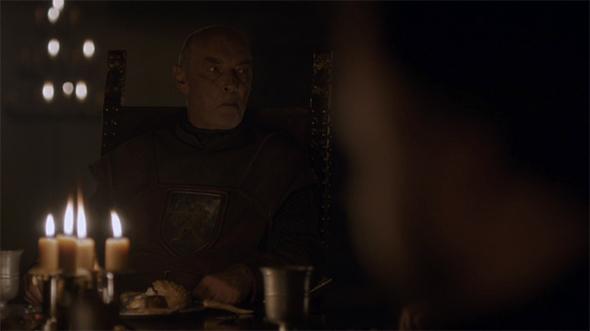
HBO
Now that Lord Tarly is in control, we see the table from his point of view for the first time:
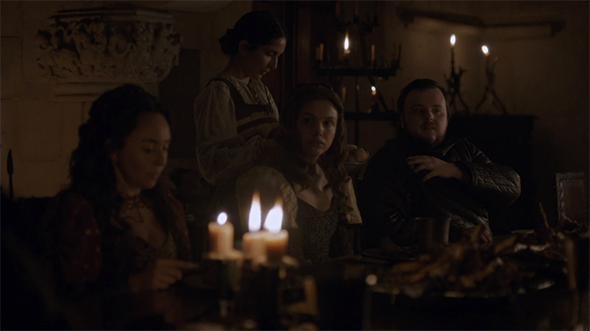
HBO
And for most of the rest of the scene, we’ll toggle between the shot of Randyll in which an out-of-focus Sam seems to be trying to will himself out of existence:
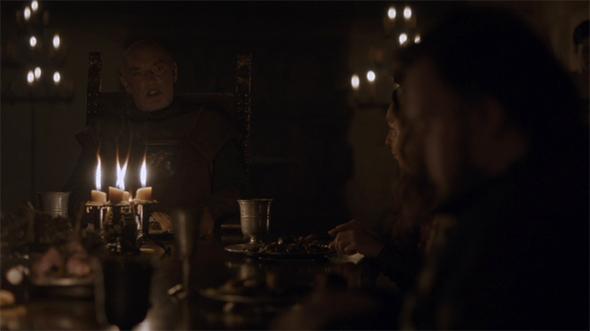
HBO
And a two shot from Randyll’s perspective in which Gilly is consistently responding and Sam is consistently staring down in shame:

HBO
So even before the scene reaches its climax, the filmmakers are carefully laying out the power arrangements and making things as uncomfortable as possible. But they’ve saved some techniques for the big finale. For all the rapid cuts, the camera hasn’t moved an inch, until Gilly misspeaks:
The second she says “down to Castle Black,” Freeman pulls the focus from Gilly to Lord Tarly:
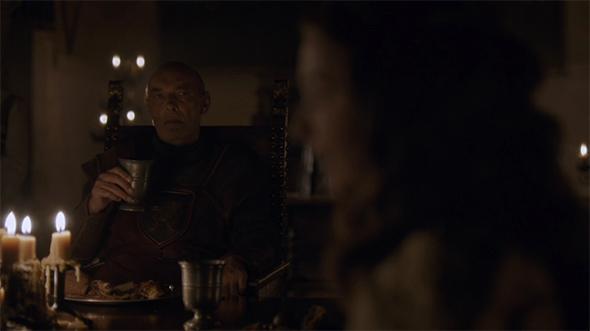
HBO
And then cuts between slow pushes in across the table toward Lord Tarly and Gilly as Tarly figures out she’s a wildling. The slow push in at a moment of realization is anything but rare, but it’s menacing here. For one thing, Gilly isn’t realizing anything, and for another, it’s disquieting to suddenly be in motion after several minutes of fixed camera shots. To underline the point, this is the first time the score kicks in, layering uneasy strings under Tarly’s lines. And there’s one more technique held in reserve:
After his rant about the family sword, Randyll Tarly finally gets his close-up, one of only two in the entire scene:
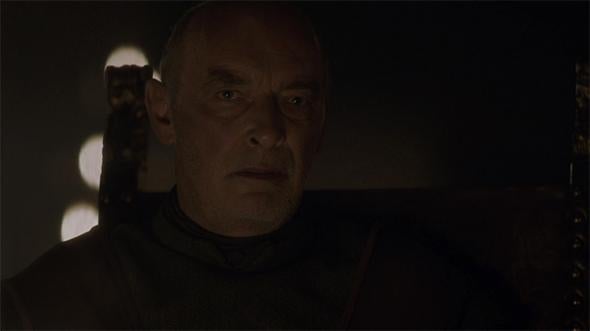
HBO
He uses it to tell the table he’s overestimated his son once again. The next shot is the framing used up to that point at moments when Sam took control of the conversation. It opens with the focus on Sam, but when it becomes clear he’s not saying anything, pulls to Gilly looking at him in disbelief:

HBO
And then Sam, too, gets his close-up, at the height of his humiliation, saying nothing.
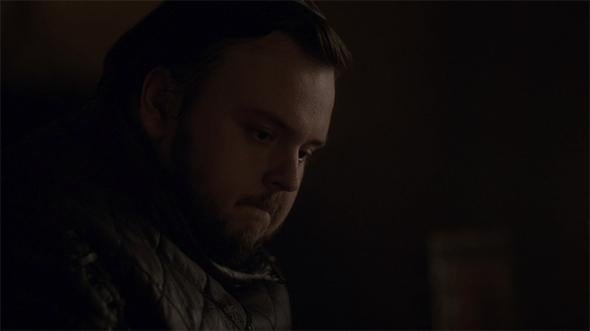
HBO
It’s a remarkable amount of craft and technique packed into a few short minutes of film. And every bit of it makes things tenser and less comfortable for Samwell Tarly and Gilly, perhaps the show’s only likable characters. In Game of Thrones, even the director, cinematographer, and editor glide in like sharks at the first sign of weakness.
